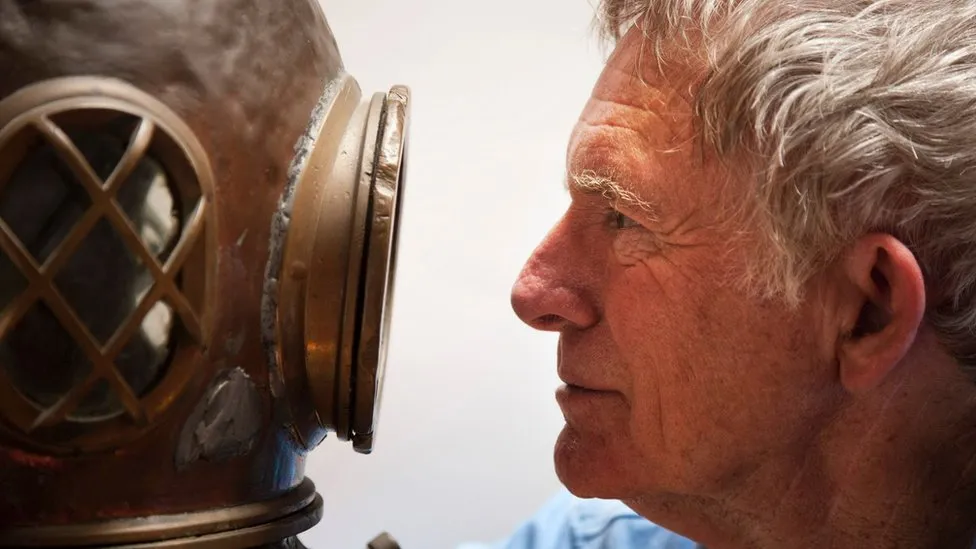Don Walsh: The man who made the deepest ever dive
Ocean explorer Captain Don Walsh has died at the age of 92. More than 60 years ago he made the first ever descent to the deepest place in the ocean, the Mariana Trench which lies almost 11km (seven miles) down. I was lucky enough to count him as a good friend. This is the story of an extraordinary dive by a remarkable man.

In 1960, space-mania was gripping the world and would-be astronauts were dreaming of their first forays skywards.
But 28-year-old Captain Don Walsh had his sights set very much downwards. He was about to descend deeper than any human had ever ventured before.
The US Navy had acquired a submersible called the bathyscaphe Trieste and Don, a submarine lieutenant, volunteered to join the project.
But when he signed up for the mission, the deepest he'd been in a sub was just 100m down. He was in for a bit of a shock - the US Navy wanted him to dive more than a hundred times deeper.
The plan was to head to the deepest place on the planet, the very bottom of the Mariana Trench, a narrow, underwater canyon, which lies in the Pacific Ocean, off the coast of Guam.
"My first reaction was 'What!? Why didn't they tell me before I volunteered?'" he told me in an interview in 2011.
"After that, I thought: 'Well, I knew the machine well enough at that point to know that, theoretically, it could be done and we could pull it off.'"
On 23 January, 1960, Don and Swiss oceanographer Jacques Piccard, who had designed the bathyscaphe with his father Auguste Piccard, began their descent beneath the waves.
They squeezed inside a thick steel-walled chamber. Don said the space was about the size of a large household refrigerator, and that the temperature inside was just about as cold too.
As the pair plunged slowly into the darkness, the craft began to creak and groan as the pressure grew.
The bathyscaphe had been built to withstand more than 1,000 times the pressure at sea level, but it had never been tested to its limits at these kinds of depths until now.
The start of the dive went smoothly, but at around 9,000m, the bathyscaphe jolted with an alarming bang.
"That was unusual - we'd never heard that before," Don later told me.
It sounded like something big had broken. Don and Jacques carefully checked their instrument readings, but everything seemed OK, so they decided to go on.
After five hours, slowly heading ever deeper, the depth-gauge passed 10,000m - but there was still no sign of the sea floor.
They began to wonder just how far down they would have to go.
But finally, the glow of the bathyscaphe's lights began to reflect back towards them. Don and Jacques had made it: at almost 11km (seven miles) down, they were at the very bottom of the Mariana Trench.
"After we landed, we stirred up a lot of sediment because that bottom sediment is semi-liquid," Don said.
"It was like looking at a bowl of milk - so we never got a photograph of the deepest place in the ocean."
There weren't any whoops or cheers at the end of this epic, record-breaking descent.
"It was just a quiet moment," Don recalled.
The pair spent about 20 minutes on the seafloor. While inspecting the craft they discovered the source of the bang they'd heard earlier.
An acrylic window inside the entrance hatch had cracked. Thankfully it wasn't a pressure boundary - if that had been the case it would have caused an instant implosion.
They were able to make it safely back to the surface.
The team had made history, receiving the Legion of Merit from US President Dwight D. Eisenhower among other medals and plaudits.
For Don, the dive came to partly define him - he used to quip that he'd spent the rest of his life "dining out" on it.
But deep-sea devotees - myself included - wanted to know about his visit to one of the most mysterious parts of the planet. And being generous - as well as very funny and humble too - he was always happy to tell the incredible tale.
But Don wasn't stuck in the past. Far from it.
His dive was just the start of a life spent advocating for the ocean, and supporting those who wanted to explore and learn about the deep.
After the navy, he became a professor of ocean engineering, he also set up a marine consultancy business and was a strong advocate for safety within the industry.
He forewarned of the Titan tragedy - the submersible that imploded on its way to the Titanic, killing all six people on board. Years before, he had written to the company's CEO warning that the lack of testing of the sub could have catastrophic consequences.
In later life, it was the Mariana Trench that grabbed his attention once again.
After Don completed his dive in 1960, he thought it would only be a couple of years before someone would return. In fact, it would be more than half a century.
In 2012, Hollywood filmmaker and ocean explorer James Cameron became the first to repeat the dive. Don was there to congratulate him after he resurfaced from his solo descent.
Don returned to the Pacific once again in 2019 when former American naval officer and explorer Victor Vescovo took the plunge.
Victor went on to take his sub to ocean trenches around the world - and with an extra seat on board, he could carry passengers.
One of these was Don's son Kelly Walsh.
Don told me that Kelly's Mariana dive was the best Father's Day gift he'd ever had - and he loved that Kelly had made it 8m deeper than he had.
Ocean and space exploration are frequently compared, and Don often joked that he had the "Right Stuff", just in the wrong direction.
He was talking about the fabled qualities - courage, daring and dependability - that made astronauts the stuff of legend. And it's true. Don had these attributes in spades.
But it's fair to say the Mariana dive never attracted the same attention as the achievements of astronauts from the same era.
Today though, I'm not so sure that Don's focus on the ocean could be described as the wrong direction.
Recent advances in technology mean that we're finally understanding the importance of the deepest sea.
While the ocean trenches were once thought of as desolate places, of little interest apart from their depth, it turns out that they're a vital part of the Earth's systems, from the weird and wonderful creatures that live there, to the important role they play in the carbon cycle and climate change.
None of this would have been possible without Don and Jacques Piccard's incredible feat so long ago.
The DNA from their dive runs right through this new era of research - it took a plunge into the unknown to start shedding light on what lies beyond the abyss.
-bbc







